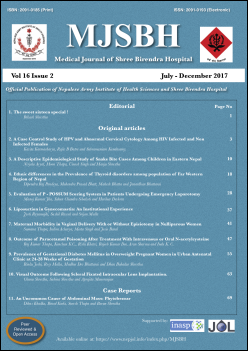Outcome of paracetamol poisoning after treatment with intravenous or oral N-acetylcysteine.
Keywords:
outcome, paracetamol poisoning, hepatotoxicity, N-acetylcysteine, intravenous, oralAbstract
Introduction: Paracetamol (PCM) is one of the most common drug in clinical practice and it is generally safe for use at recommended doses. However, its overdose can cause mild hepatotoxicity to severe hepatic necrosis and even hepatic failure. N-acetylcysteine (NAC) is the standard recommended antidote for PCM poisoning which is available in both intravenous (IV) and oral formulations. This study aimed to measure outcome in PCM poisoning after treatment with oral or IV NAC.
Methods: A descriptive cross-sectional study was conducted in randomly selected 50 consecutive patients presented within 72 hours of PCM poisoning. Comparative outcomes measured in correlation of dynamics of liver enzymes alanine aminotransferase, aspartate aminotransferase and prothrombin time along with development of adverse drug reactions and clinical cure rate. Comparison of categorical variables by Chi-square test and Fisher's test and the comparison of mean between groups by Student's t-test with p-value <0.05 as statistically significant.
Results: Among 50 cases 20 (40%) were treated with oral NAC and 30 (60%) with IV NAC. PCM poisoning was more common in young adults (15-30 years) with mean age of 19 (n=43; 86%) and most of them had taken with an intent of suicide (n=47; 94%). Majority of patients were asymptomatic at presentation with female preponderance (M:F=1:4; 80%). There was no statistical difference in both the treatment groups and as an outcome measure there were no severe liver enzymes derangement, no serious adverse drug reactions and 100% clinical cure rate.
Conclusion: NAC in both IV and oral forms are equally effective as an antidote in PCM poisoning.
Downloads
Downloads
Published
How to Cite
Issue
Section
License
This license enables reusers to distribute, remix, adapt, and build upon the material in any medium or format for noncommercial purposes only, and only so long as attribution is given to the creator.




